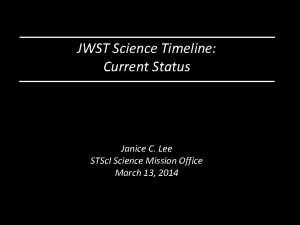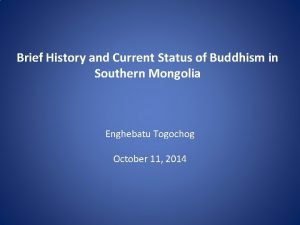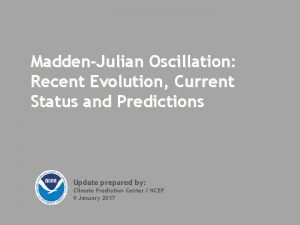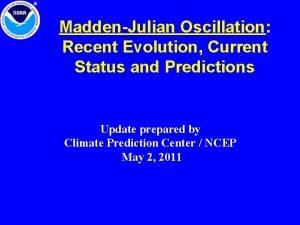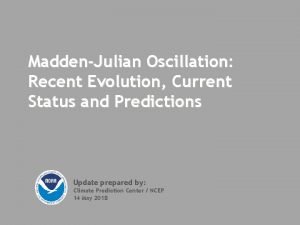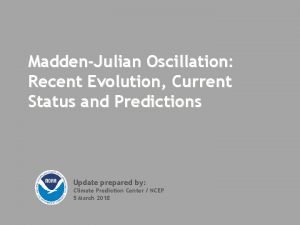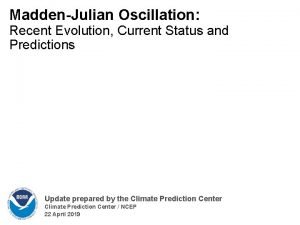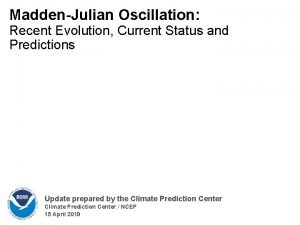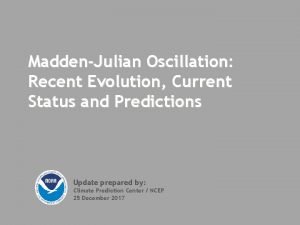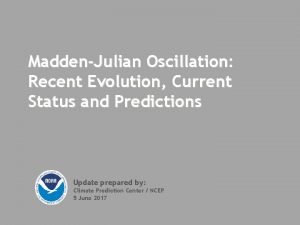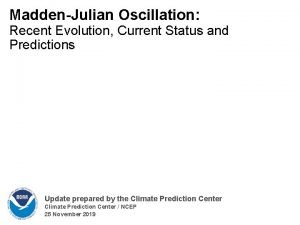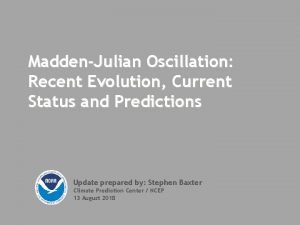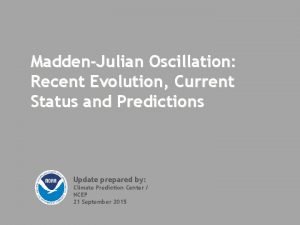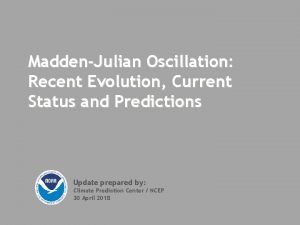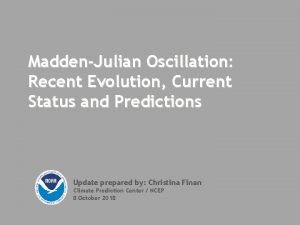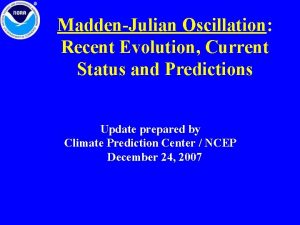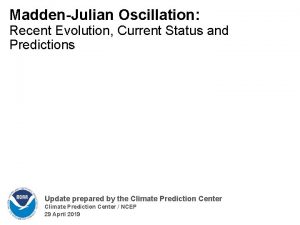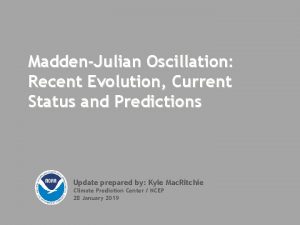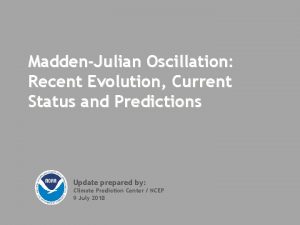MaddenJulian Oscillation Recent Evolution Current Status and Predictions



















- Slides: 19

Madden-Julian Oscillation: Recent Evolution, Current Status and Predictions Update prepared by Climate Prediction Center / NCEP June 14, 2010

Outline • Overview • Recent Evolution and Current Conditions • MJO Index Information • MJO Index Forecasts • MJO Composites

Overview • The MJO remained weak during the past week as indicated by recent observations. • There is considerable agreement in solutions from dynamical model MJO index forecasts for the coming two weeks. Most models indicate a signal across the Indian Ocean during the period, however, due to a lack of eastward propagation it is likely that this signal is a combination of subseasonal variability rather than a coherent MJO emerging. • Based on a combination of the latest observations and MJO statistical and dynamical forecast tools, the MJO is expected to remain weak over the period. • The MJO is not expected to contribute substantially to anomalous tropical rainfall during the next 1 -2 weeks. Additional potential impacts across the global tropics are available at: http: //www. cpc. ncep. noaa. gov/products/precip/CWlink/ghazards/ghaz. shtml

850 -h. Pa Vector Wind Anomalies (m s-1) Note that shading denotes the zonal wind anomaly Blue shades: Easterly anomalies Red shades: Westerly anomalies Easterly anomalies weakened during the past five days across the equatorial Indian Ocean and have persisted over the western Pacific. Westerly anomalies persisted across the eastern Pacific during the latest five days. Westerly anomalies have strengthened during the last five days over the Atlantic.

850 -h. Pa Zonal Wind Anomalies (m s-1) Westerly anomalies (orange/red shading) represent anomalous west-to-east flow Easterly anomalies (blue shading) represent anomalous east-to-west flow Westerly anomalies (dashed line) developed across the Indian Ocean and shifted eastward across the Date Line during late December and were associated with the MJO. Time Weaker and shorter-lived MJO activity was evident during January (dotted and dashed line). Easterly anomalies have persisted in the west-central Pacific since mid-March (black box). Strong westerly anomalies (red dotted ovals) have occurred across the eastern Pacific on separate occasions during late April/early May associated with the MJO and again in late May. Longitude

OLR Anomalies: Last 30 days Drier-than-normal conditions, positive OLR anomalies (yellow/red shading) Wetter-than-normal conditions, negative OLR anomalies (blue shading) Enhanced convection persisted across the Indian Ocean, the Maritime continent, and portions of India during mid May. Suppressed convection was evident over Central and South America and much of Africa during this period. In late May, suppressed convection began to replace enhanced convection across the equatorial Indian Ocean and persisted in the western Pacific. Enhanced convection developed over Central America and the Caribbean. Suppressed convection was evident over southern India and western Indian Ocean during early June. Suppressed convection replaced enhanced convection across parts of the east Pacific and Caribbean.

Outgoing Longwave Radiation (OLR) Anomalies (7. 5°S-7. 5°N) Drier-than-normal conditions, positive OLR anomalies (yellow/red shading) Wetter-than-normal conditions, negative OLR anomalies (blue shading) (Courtesy of the Bureau of Meteorology (BOM) Australia) MJO activity was evident during January 2010. Time The MJO was not active during February and March as anomalous convection was more persistent across the Maritime continent (suppressed) and west-central Pacific (enhanced). Anomalies were small during the month of April. Enhanced convection, in part associated with MJO activity, developed across the Indian Ocean in early May and shifted slightly eastward. Suppressed convection developed after this across much of Africa. Longitude

200 -h. Pa Velocity Potential Anomalies (5°S-5°N) Positive anomalies (brown shading) indicate unfavorable conditions for precipitation Negative anomalies (green shading) indicate favorable conditions for precipitation Eastward propagation associated with the MJO was evident during early-mid January (red box). During February and the first half of March, the MJO weakened anomalies became more stationary and incoherent on the intraseasonal time scale (black boxes). Time In mid-March, weak upper-level divergence (convergence) developed over Africa and the Indian Ocean (Maritime continent) and these anomalies propagated eastward. In late April and early May, anomalies increased and eastward propagation was evident coincident with the MJO. Most recently in late May and early June, weak upper-level anomalies are evident and propagating. Longitude

IR Temperatures (K) / 200 -h. Pa Velocity Potential Anomalies Positive anomalies (brown contours) indicate unfavorable conditions for precipitation Negative anomalies (green contours) indicate favorable conditions for precipitation The current anomalous velocity potential pattern indicates upper-level divergence over Africa with upper-level convergence evident over the Maritime Continent and western Pacific.

200 -h. Pa Vector Wind Anomalies (m s-1) Note that shading denotes the zonal wind anomaly Blue shades: Easterly anomalies Red shades: Westerly anomalies Easterly anomalies are evident across the equatorial eastern Pacific, northern South America and the Atlantic during the last five days (blue box). Weak westerly anomalies are evident across the equatorial Indian Ocean, Maritime Continent, and the western Pacific (red box).

200 -h. Pa Zonal Wind Anomalies (m s-1) Westerly anomalies (orange/red shading) represent anomalous west-toeast flow Easterly anomalies (blue shading) represent anomalous east-to-west flow Easterly anomalies dominated much of the central and eastern Pacific during the second half of December and most of January (black oval). Time Westerly anomalies prevailed across the central Pacific (red box) for much of the period since mid-March to mid-May. In early May, however, there was some eastward propagation of westerly anomalies across the Pacific in association with the MJO at that time. Longitude

Weekly Heat Content Evolution in the Equatorial Pacific From June 2009 through March 2010, heat content anomalies remained aboveaverage for much of the period. Time From November 2009 – February 2010 three ocean Kelvin waves contributed to the change in heat content across the eastern Pacific (last three dashed black lines). During April 2010 heat content anomalies decreased across the Pacific in association with the upwelling phase of a Kelvin wave. Currently, negative heat content anomalies extend across the central and east-central Pacific. Longitude

MJO Index -- Information • The MJO index illustrated on the next several slides is the CPC version of the Wheeler and Hendon index (2004, hereafter WH 2004). Wheeler M. and H. Hendon, 2004: An All-Season Real-Time Multivariate MJO Index: Development of an Index for Monitoring and Prediction, Monthly Weather Review, 132, 1917 -1932. • The methodology is very similar to that described in WH 2004 but does not include the linear removal of ENSO variability associated with a sea surface temperature index. The methodology is consistent with that outlined by the U. S. CLIVAR MJO Working Group. Gottschalck et al. 2010: A Framework for Assessing Operational Model MJO Forecasts: A Project of the CLIVAR Madden-Julian Oscillation Working Group, Bull. Amer. Met. Soc. , Accepted. • The index is based on a combined Empirical Orthogonal Function (EOF) analysis using fields of near-equatorially-averaged 850 -h. Pa and 200 -h. Pa zonal wind and outgoing longwave radiation (OLR).

MJO Index -- Recent Evolution § The axes (RMM 1 and RMM 2) represent daily values of the principal components from the two leading modes § The triangular areas indicate the location of the enhanced phase of the MJO § Counter-clockwise motion is indicative of eastward propagation. Large dot most recent observation. § Distance from the origin is proportional to MJO strength § Line colors distinguish different months During the past week, the MJO index showed increased amplitude, however with marginal propagation indicating weak MJO activity.

MJO Index – Historical Daily Time Series Time series of daily MJO index amplitude from 1995 to present. Plots put current MJO activity in historical context.

Ensemble GFS (GEFS) MJO Forecast Yellow Lines – 20 Individual Members Green Line – Ensemble Mean RMM 1 and RMM 2 values for the most recent 40 days and forecasts from the ensemble Global Forecast System (GEFS) for the next 15 days light gray shading: 90% of forecasts dark gray shading: 50% of forecasts The GFS forecasts indicate a strengthening MJO signal during Week-1 with no eastward propagation. Spread is small. At this time, it appears that the increase in signal is likely due to a combination of subseasonal variability as opposed to a more coherent MJO signal emerging.

Ensemble Mean GFS MJO Forecast Figures below show MJO associated OLR anomalies only (reconstructed from RMM 1 and RMM 2) and do not include contributions from other modes (i. e. , ENSO, monsoons) Spatial map of OLR anomalies for the next 15 days The GEFS ensemble mean forecast indicates enhanced convection developing across the Indian Ocean and Maritime Continent and persisting through the end of the period. Suppressed convection is forecast across the western and central Pacific Ocean during the period. Time-longitude section of (7. 5°S-7. 5°N) OLR anomalies for the last 180 days and for the next 15 days

Statistical MJO Forecast Figure below shows MJO associated OLR anomalies only (reconstructed from RMM 1 and RMM 2) and do not include contributions from other modes (i. e. , ENSO, monsoons) Spatial map of OLR anomalies and 850 -h. Pa vectors for the next 20 days (Courtesy of the Bureau of Meteorology Research Centre - Australia) The statistical forecast indicates weak MJO activity during the next two weeks.

MJO Composites – Global Tropics Precipitation Anomalies (May-Sep) 850 -h. Pa Wind Anomalies (May-Sep)
 Line current and phase current
Line current and phase current Difference between phase voltage and line voltage
Difference between phase voltage and line voltage Drift current and diffusion current
Drift current and diffusion current Ac systems lesson 4
Ac systems lesson 4 Drift current density unit
Drift current density unit What is diffusion current and drift current
What is diffusion current and drift current In a triangle connected source feeding a y connected load
In a triangle connected source feeding a y connected load Holding current and latching current
Holding current and latching current Drift current density unit
Drift current density unit Modes of motion in size separation agitation
Modes of motion in size separation agitation At cut off the jfet channel is
At cut off the jfet channel is In alternators the welding current is produced on the
In alternators the welding current is produced on the Hazard based safety engineering
Hazard based safety engineering Non planar circuit
Non planar circuit Cpsr register diagram
Cpsr register diagram Jwst commissioning timeline
Jwst commissioning timeline Current status of buddhism
Current status of buddhism Periodic motion examples images
Periodic motion examples images Indication and contraindication of mobilization
Indication and contraindication of mobilization Accessory joint motion
Accessory joint motion















